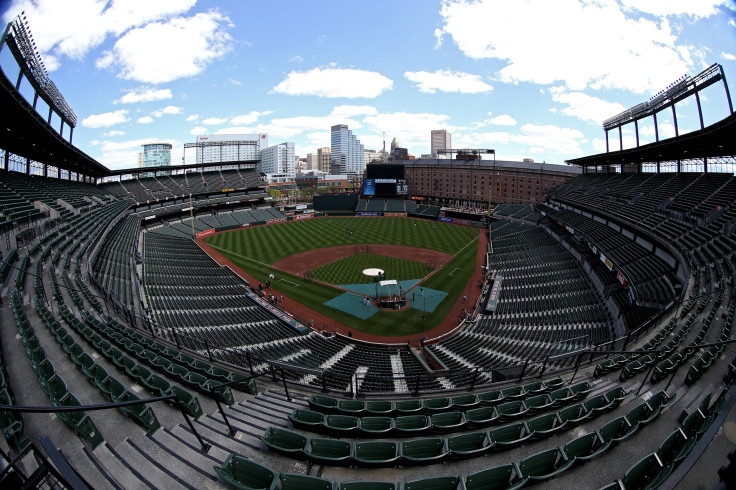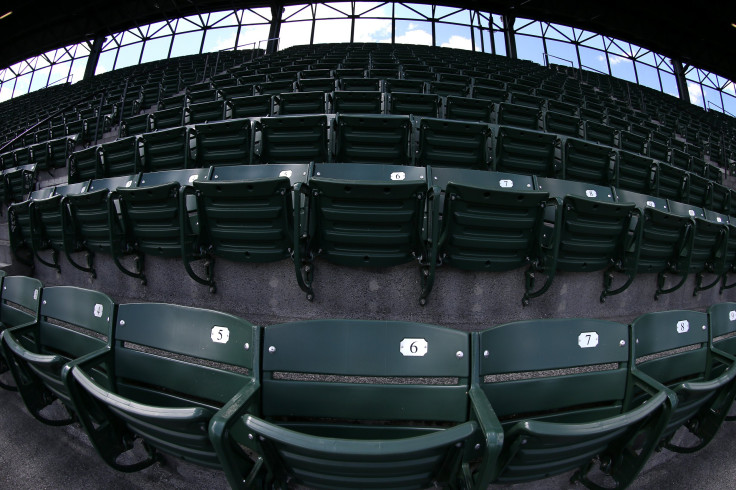Orioles-White Sox And Empty Camden Yards: Stadium Built For Economic Boon Will Host No Fans Following Baltimore Riots

Oriole Park at Camden Yards, its construction finished in downtown Baltimore in 1992, was perhaps the first of its kind: a redbrick, old-style ballpark -- rife with quirk but full of modern features -- squat in a downtown area in need of revitalization. But when the Baltimore Orioles took the field Wednesday at 2:05 p.m. against the Chicago White Sox, the game-changing ballpark, seating capacity nearly 49,000, was empty.
Attendance was already set at zero in the pressbox ahead of what's believed to be the first-ever Major League Baseball game shut off from the public, following days of violent unrest and protests over the death of local man Freddie Gray a few days after he suffered a severe spinal injury while in police custody. As the protests over Gray's death grew increasingly tumultuous Saturday night, a good portion of the damage took place outside of Camden Yards. Fans were not able to leave the stadium as the standoff between police and protesters intensified. Orioles games scheduled for Monday and Tuesday were postponed, but Wednesday's was scheduled to take place in front of an Oriole Park devoid of fans. So the usual economic boost from the downtown stadium will be negated precisely because of its location.
"Building Camden Yards was one of the most important things that happened to baseball in the last 20 to 25 years," Major League Baseball commissioner Allan H. "Bud" Selig said in 2012 to the Baltimore Sun. "It changed the whole dynamic. It led to all these wonderful stadiums and allowed us to finally market our sport to its potential -- particularly the last five years of terrific growth.
"It set it all off. It never would have happened without Camden Yards. But I don't think anybody could really have understood how dramatically it was going to change the face of baseball and the Orioles."
Camden Yards attendance today already noted on the press box dry erase board ... @FOXSports @foxnews pic.twitter.com/pDyrNHB6aw
— Jon Morosi (@jonmorosi) April 29, 2015Before Camden Yards, cookie-cutter multisport stadiums were the rage. Camden Yards was starkly different. It was built specifically for baseball, and near the Inner Harbor in Baltimore, the catalyst of an image shift for the area. The stadium -- constructed with $110 million of state lottery ticket earnings -- is rented long-term by the team and feeds tax dollars, as well as fan-spent money, to local business owners. The purposeful downtown location was a shift away from the behemoth stadia across America that were surrounded by seas of parking lot. Camden Yards was immediately popular as a tourist destination -- boosting out-of-town attendance by 76 percent in year one -- and became the model and benchmark for new stadiums in Pittsburgh, Houston, Washington, D.C., or any number of cities.
The new Oriole Park was meant to be a boon for the local economy, supplying business to the Inner Harbor area and feeding tax dollars to the state, which made a significant investment. Camden Yards was one of the big stepping stones in revitalizing the harbor area, which now houses the NFL's Baltimore Ravens, the sparkling National Aquarium, a host of shops and restaurants with patios overlooking the water, and scenic promenades. The area, called Harborplace, had seen its visitors sag from 18 million to about 11 million per year, according to Forbes. Camden Yards helped bring the area back to life.

“It was getting harder to lure locals back downtown at night and on weekends,” said Bill Stetka, director of media relations for the Orioles to Forbes in 2009. “So the construction of the ballpark at Camden Yards dramatically facilitated a resurgence in people re-experiencing downtown, the Inner Harbor and re-emerging neighborhoods to the east.”
The Maryland Stadium Authority estimated in 2006 (its most recent study) that the park generated $166.9 million in gross state product (business sales), produced $17.95 million in total tax revenue and created 2,452 Maryland jobs. For fiscal year 2014 the Orioles also paid $7,205,224 in rent.
The money centered on Camden Yards is not limited to state revenues and local businesses. Forbes estimated the Orioles take in $60 million from the gate in any given season. For a very rough calculation of the ticket sales lost in Wednesday's game, just divide that total by 81 (amount of home games in a regular season). The answer: roughly $740,740 squandered in sales. The Orioles also shifted three home games against the Tampa Bay Rays May 1-3 to the Ray's stadium in St. Petersburg. Using the same method, that's about $2.2 million more lost at the gate.
Local businesses are likely also feeling the effects of an unpopulated ballpark. Craig Ziegenhein, 28, is manager of Pickles Pub, a local favorite down the street from Camden Yards. He said the pub is "running happy hour specials all day" and is hopeful people will make the trip to support the team. But then again, the game was moved from a night matchup to a 2:05 p.m. game on a Wednesday, so it’s hard to get fans out in droves on a workday.
#WhiteSox are back at work. Batting practice has begun at Oriole Park at Camden Yards. pic.twitter.com/U90f4RvDzu
— Dan Hayes (@CSNHayes) April 29, 2015Oriole Park at Camden Yards is about one mile from Baltimore City Hall and around 2.5 miles from Gilmor Homes, where Gray was arrested, near the center of the city and where protests are bound to gravitate to. Because it is downtown and near the heart of things -- and perhaps because it is a symbol of upscale, gentrified Baltimore, as the Nation argued -- it became a place where unrest could come to a head. When the Orioles take to the diamond Wednesday -- in a stadium designed to boost the local economy, MLB and the city of Baltimore -- what was a chaotic epicenter just days ago will be eerily quiet.
© Copyright IBTimes 2024. All rights reserved.






















